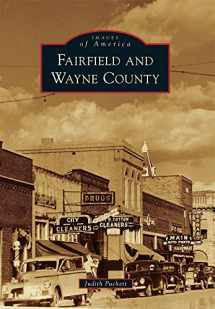
Fairfield and Wayne County (Images of America)
ISBN-13:
9780738593562
ISBN-10:
0738593567
Edition:
Illustrated
Author:
Judith Puckett
Publication date:
2012
Publisher:
Arcadia Publishing
Format:
Paperback
128 pages
Category:
History
,
Photography & Video
,
Travel
,
State & Local
,
United States History
FREE US shipping
Book details
ISBN-13:
9780738593562
ISBN-10:
0738593567
Edition:
Illustrated
Author:
Judith Puckett
Publication date:
2012
Publisher:
Arcadia Publishing
Format:
Paperback
128 pages
Category:
History
,
Photography & Video
,
Travel
,
State & Local
,
United States History
Summary
Fairfield and Wayne County (Images of America) (ISBN-13: 9780738593562 and ISBN-10: 0738593567), written by authors
Judith Puckett, was published by Arcadia Publishing in 2012.
With an overall rating of 3.5 stars, it's a notable title among other
History
(Photography & Video, Travel, State & Local, United States History) books. You can easily purchase or rent Fairfield and Wayne County (Images of America) (Paperback) from BooksRun,
along with many other new and used
History
books
and textbooks.
And, if you're looking to sell your copy, our current buyback offer is $0.3.
Description
Known as the home of the Prohibition-era Shelton Brothers Gang, the true heritage of Wayne County, Illinois, is the collective life of its ordinary citizens―their surroundings, activities, and challenges. In 1819, settlers named the county seat Fairfield because there was “no fairer field” than the broad prairie between the timberlands. Villages scattered across the 715-square-mile county attracted families, teachers, doctors, blacksmiths, ministers, and merchandisers. The railroad brought prosperity. Fairfield’s opera house, college, woolen mill, stately churches, elegant homes, and packed business district made it a social hub. In the 1900s, Sexton Manufacturing added a massive factory complex, including Cambridge Court cottages for unmarried female workers. On farms, poultry production reached industry levels. By the 1920s, the county had over 100 one-room schools. The discovery of oil in 1937 relieved Depression-era woes and fueled Fairfield’s civic expansion after World War II. These photographs show generations of shopkeepers, students, farmers, musicians, builders, barbers, teachers, merchants, and factory workers in the heart of the rural Midwest.


We would LOVE it if you could help us and other readers by reviewing the book
Book review

Congratulations! We have received your book review.
{user}
{createdAt}
by {truncated_author}


